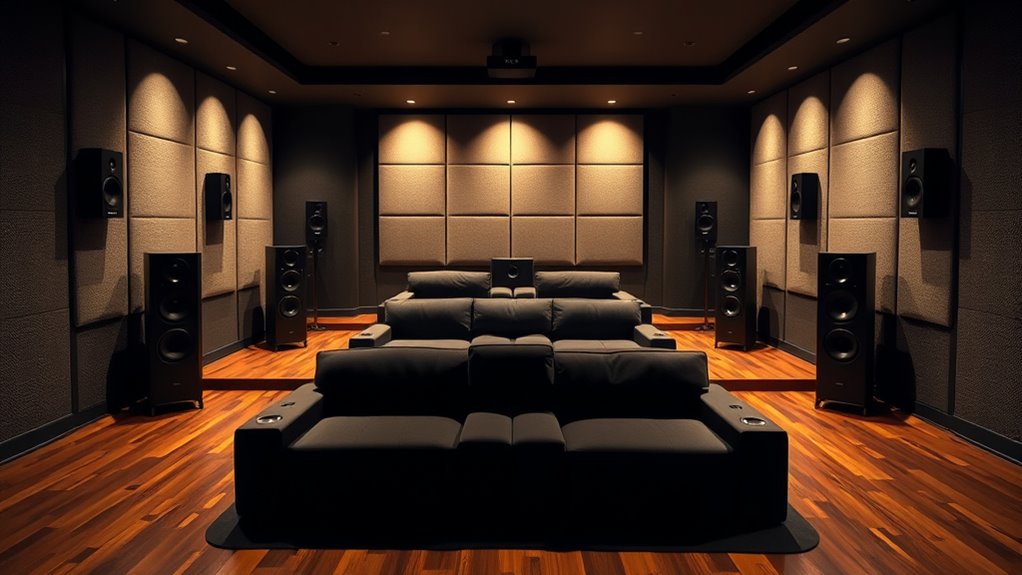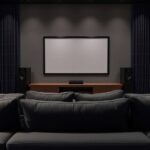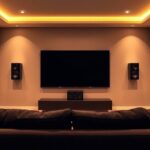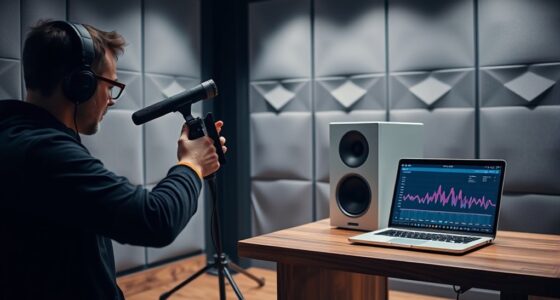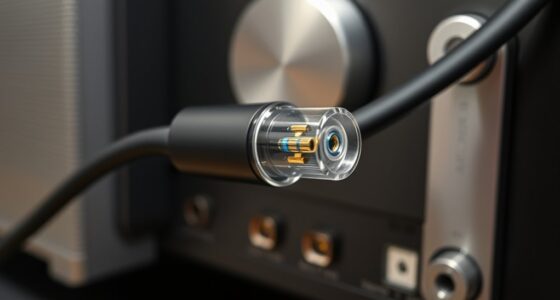To master speaker placement, start by evaluating your room’s acoustics and identifying reflective surfaces like walls and windows. Position your speakers away from walls and corners to prevent exaggerated bass and echo. Aim them toward your listening spot and adjust their height and angle for the best sound. Consider room treatments with soft furnishings or absorption panels to reduce reverberations. For more detailed strategies, explore how proper placement and acoustic adjustments can elevate your sound experience.
Key Takeaways
- Identify and minimize reflective surfaces to prevent sound muddiness and echo.
- Position speakers slightly away from walls and corners for balanced bass and clear soundstage.
- Aim speakers toward the listening area, adjusting height and angle for optimal sound delivery.
- Use calibration tools or apps to fine-tune speaker levels, distances, and equalization settings.
- Incorporate room treatments like carpets, curtains, or acoustic panels to absorb reflections and enhance clarity.
Optimizing Room Acoustics for Speaker Placement

Proper speaker placement is key to achieving ideal sound quality in any space. When you focus on how your speakers are positioned, you considerably influence the overall listening experience. One of the most important factors to consider is room acoustics, which directly impacts how sound travels and reflects within your environment. Hard surfaces like tile or glass can cause excessive reflections, creating echo and muddiness, while soft furnishings like curtains, carpets, and furniture help absorb sound and reduce unwanted reverberations. Understanding your room’s unique acoustic properties allows you to tailor your speaker placement for the best sound clarity and balance.
To optimize your setup, you need to think about how sound waves interact with your space. Start by identifying reflective surfaces and adjusting your speaker positions to minimize their impact. For example, if your speakers are too close to walls or corners, you might experience exaggerated bass or boomy sound. Moving them slightly away from boundaries can help create a more natural and balanced soundstage. Also, consider the height and angle of your speakers; aiming them toward your listening position ensures that sound reaches your ears directly, rather than bouncing off surfaces. This simple adjustment can considerably improve clarity and imaging. Additionally, understanding room acoustics can help you implement more effective placement strategies.
Another vital step is speaker calibration. Once you have your speakers roughly in the right spots, calibration ensures they work together harmoniously. Many modern systems include automatic calibration tools that use microphones to measure sound output and adjust settings accordingly. If you’re doing it manually, you can use a calibration microphone or even a smartphone app to analyze the sound at your listening position. Fine-tuning speaker levels, distances, and equalization settings ensures that each speaker contributes appropriately to the overall soundstage. Proper calibration compensates for room acoustics quirks, allowing your system to produce a more accurate and immersive sound experience. Additionally, considering the educational benefits of sensory toys can help you understand how various materials and surfaces influence sound absorption and reflection, aiding in more effective room treatment decisions. Being aware of acoustic properties and how they affect sound can help you make more informed placement choices to optimize your listening environment. Recognizing how sound reflection and absorption affect audio quality can guide you in selecting the right materials to enhance your setup, and exploring soundproofing techniques may further improve overall sound clarity by reducing external noise interference.
Frequently Asked Questions
How Do I Choose the Best Speaker Placement for Different Room Sizes?
To select the best speaker placement for different room sizes, start by considering speaker distance and room acoustics. In smaller rooms, place speakers closer to walls to boost bass but avoid corners to prevent muddy sound. In larger rooms, position speakers farther apart and away from walls to ensure balanced sound coverage. Adjust based on acoustics, adding acoustic panels if needed, to optimize clarity and minimize echoes.
What Are Common Mistakes to Avoid in Speaker Positioning?
Avoid common speaker placement mistakes by not ignoring room acoustics or positioning speakers too close to walls. You should also steer clear of uneven speaker distances, which can cause phase issues and sound imbalance. Don’t overlook the importance of listening tests and adjusting angles for ideal sound. Ensuring symmetrical placement and considering furniture or objects that affect acoustics helps prevent reflections and echoes, delivering clearer, more accurate audio.
How Does Furniture Placement Affect Speaker Sound Quality?
Furniture placement markedly impacts speaker sound quality by causing furniture interference and acoustic reflections. When you position large pieces near your speakers, they can block or absorb sound waves, reducing clarity. Similarly, reflective surfaces like glass or bare walls can create echo and muddle sound. To improve audio, keep furniture away from speakers and use soft furnishings to minimize reflections, ensuring a cleaner, more accurate listening experience.
Can Speaker Placement Improve Bass Response Significantly?
Yes, speaker placement can markedly improve bass response through bass optimization. By positioning your speakers correctly, you enhance low-frequency projection and reduce muddiness. Use speaker calibration tools to fine-tune the sound, ensuring the bass is punchy and well-defined. Experiment with placement, such as angling speakers or adjusting their distance from walls, to achieve the best bass response and overall sound clarity in your space.
Are There Specific Tools or Apps to Help Optimize Speaker Placement?
Yes, there are specific tools and apps to help optimize your speaker placement. Calibration apps and placement calculators are popular options; calibration apps analyze sound quality and adjust settings for the best performance, while placement calculators suggest ideal speaker positions based on room dimensions. Using these tools, you can easily fine-tune your setup for balanced bass, clearer sound, and an immersive listening experience.
Conclusion
Now that you know how to optimize your room, how to place your speakers, and how to fine-tune your setup, you’re ready to enjoy better sound, clearer dialogue, and richer music. By applying these principles, you’ll create an immersive listening experience, improve your audio quality, and enjoy your favorite content more fully. Remember, good placement isn’t just about positioning; it’s about transforming your space into a true audio haven. Happy listening!
